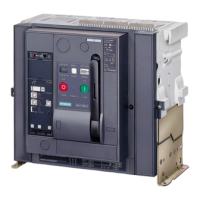WL Communication-capable Circuit Breaker
2/4
WL Selection and Application Guide • 2005
WL Circuit Breaker
Communication Modules
The demands on power
distribution with regard to
communication capability,
data transparency, flexibility
and integration are constantly
on the increase. In order to
ensure that WL Circuit Breakers
are able to fulfill these
demands, WL Circuit Breakers
have a consistent and modular
communication architecture.
CubicleBUS forms the
backbone of this architecture.
CubicleBUS is a breaker-
internal system bus that
connects all intelligent
components in the WL Circuit
Breaker and enables easy
connection of external
components to the circuit
breaker. CubicleBUS is already
incorporated and connected in
all complete circuit breakers
with ETU745, ETU748, ETU755,
and ETU776 trip units.
The modular design of the
system allows the retrofitting
of communication functions
at any time. This also allows
trouble-free and local upgrad-
ing of a WL Circuit Breaker that
does not yet have commun-
ication capability. All modules
on the CubicleBUS directly
access the available data of
the circuit breaker, thus
ensuring the fastest possible
access to information and
response to events. The
connection of additional
CubicleBUS modules to
the CubicleBUS allows
implementation of cost-
effective solutions in
the switchgear.
Breaker Status Sensor (BSS)
The switches that sense the
status of the circuit breaker are
mounted on or connected to
the Breaker Status Sensor
(BSS). The BSS provides the
following data on the
CubicleBUS:
• OPEN / CLOSE
• Trip Status
• Closing Spring Charged
• Ready to close
• Undervoltage release
In addition, the BSS contains
a temperature sensor which
measures and communicates
the temperature in the circuit
breaker.
If optional communications is
specified, the BSS is already
integrated in the circuit breaker
and is connected and fully
operational. As a retrofit part,
the BSS is a simple Click &
Place device that can
be easily inserted
in the correct
position and
connected to
the preassembled
cable.
Metering Function/
Metering Function PLUS
The integrated metering
function can be installed on
all ETU745, ETU748, ETU755,
and ETU776 trip units and
provides a viable alternative
to external multi-function
measuring instruments in many
applications.
Metering Function can
measure the following:
• Currents
• Voltages
• Power
• Energy
• Power Factor
• Frequency
All metered quantities are
delivered as real time values
with min/max recording. The
metering module also
contains additional alarm
setpoint and protective relay
functions (e.g. trip on
overfrequency or
undervoltage, and alarm on
reverse power or over ampere
demand).
The Metering Function PLUS
has two additional wave form
buffers and supports harmonic
analysis. With the two indepen-
dent wave form buffers, the
current and voltage
waveforms can be recorded,
and allows detailed diagnostic
triggering on events.
If the Metering Function /
Metering Function
PLUS is ordered
together with the
circuit breaker, it is
already installed and
ready for operation.
As a retrofit part, the
metering function is
simply attached to the
ETU and connected
to the CubicleBUS.
COM16 MODBUS Module or
COM15 PROFIBUS Module
The COM16 MODBUS module
or COM15 PROFIBUS module
enables direct connection of
the circuit breaker to MODBUS
and PROFIBUS systems.
With the COM15 or COM16,
ETU parameters can be
changed and the breaker can
be open and closed remotely.
The position of the circuit
breaker (connected, test,
disconnected) is detected
by switches on the COM15/16
and communicated.
A temperature sensor
integrated in the COM15/16
measures and communicates
the temperature around the
circuit breaker. An integrated
clock adds a time stamp to all
events and min/max values
and can be synchronized via
communications. If
communications is specified,
the module (and the breaker
status sensor) are already
installed, connected and fully
functional. As a retrofit part
the COM15/16 simply needs
to be snapped into position in
the secondary disconnect
block mounting rail and
wired into the system.
General
WL_SA_sec 2-3.qxd 2/7/05 2:20 PM Page 4

